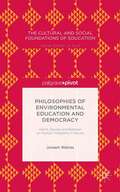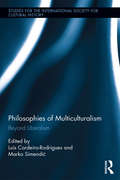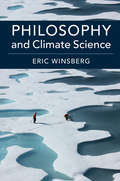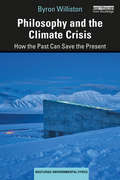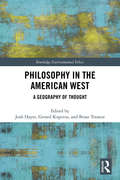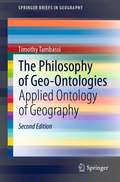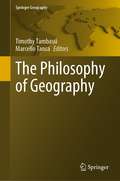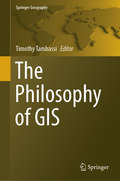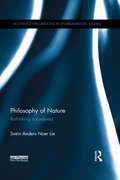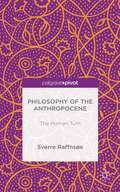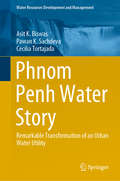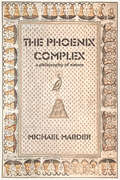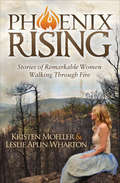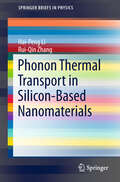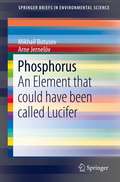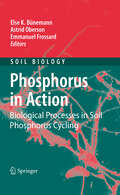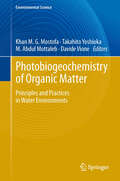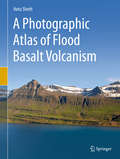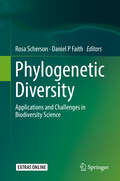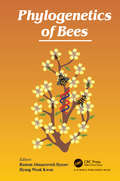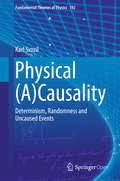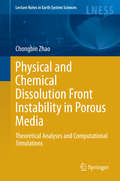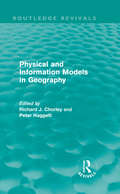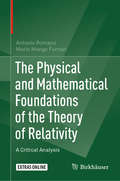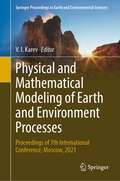- Table View
- List View
Philosophies of Environmental Education and Democracy: Harris, Dewey, and Bateson on Human Freedoms in Nature
by Joseph WatrasThe project examines how three prominent philosophers of education - William Torrey Harris, John Dewey, and Gregory Bateson - each developed a world view that provides a philosophical basis for environmental education.
Philosophies of Multiculturalism: Beyond Liberalism (Studies for the International Society for Cultural History #9)
by Luis Cordeiro-Rodrigues Marko SimendicThis edited collection offers a comparative approach to the topic of multiculturalism, including different authors with contrasting arguments from different philosophical traditions and ideologies. It puts together perspectives that have been largely neglected as valid normative ways to address the political and moral questions that arise from the coexistence of different cultures in the same geographical space. The essays in this volume cover both historical perspectives, taking in the work of Hobbes, Tocqueville and Nietzsche among others, and contemporary Eastern and Western approaches, including Marxism, anarchism, Islam, Daoism, Indian and African philosophies.
Philosophy and Climate Science
by Eric WinsbergThere continues to be a vigorous public debate in our society about the status of climate science. Much of the skepticism voiced in this debate suffers from a lack of understanding of how the science works - in particular the complex interdisciplinary scientific modeling activities such as those which are at the heart of climate science. <P><P>In this book Eric Winsberg shows clearly and accessibly how philosophy of science can contribute to our understanding of climate science, and how it can also shape climate policy debates and provide a starting point for research.<P>Covering a wide range of topics including the nature of scientific data, modeling, and simulation, his book provides a detailed guide for those willing to look beyond ideological proclamations, and enriches our understanding of how climate science relates to important concepts such as chaos, unpredictability, and the extent of what we know.<P> Provides a comprehensive and accessible introduction to the philosophy of climate science.<P> Advances our understanding of how philosophy can contribute to debates in climate science.<P> Offers useful case studies and suggestions for further reading.
Philosophy and the Climate Crisis: How the Past Can Save the Present (Routledge Environmental Ethics)
by Byron WillistonThis book explores how the history of philosophy can orient us to the new reality brought on by the climate crisis. If we understand the climate crisis as a deeply existential one, it can help to examine the way past philosophers responded to similar crises in their times. This book explores five past crises, each involving a unique form of collective trauma. These events—war, occupation, exile, scientific revolution and political revolution—inspired the philosophers to remake the whole world in thought, to construct a metaphysics. Williston distills a key intellectual innovation from each metaphysical system: • That political power must be constrained by knowledge of the climate system (Plato) • That ethical and political reasoning must be informed by care or love of the ecological whole (Augustine) • That we must enhance the design of the technosphere (Descartes) • That we must conceive the Earth as an internally complex system (Spinoza) • And that we must grant rights to anyone or anything—ultimately the Earth system itself—whose vital interests are threatened by the effects of climate change (Hegel). Philosophy and the Climate Crisis will be of great interest to students and scholars of climate change, environmental philosophy and ethics and the environmental humanities.
Philosophy in the American West: A Geography of Thought (Routledge Environmental Ethics)
by Josh Hayes Gerard Kuperus Brian TreanorPhilosophy in the American West explores the physical, ecological, cultural, and narrative environments associated with the western United States, reflecting on the relationship between people and the places that sustain them. The American West has long been recognized as having significance. From Crèvecoeur’s early observations in Letters from an American Farmer (1782), to Thoreau’s reflections in Walden (1854), to twentieth-century thoughts on the legacy of a vanishing frontier, "the West" has played a pivotal role in the American narrative and in the American sense of self. But while the nature of "westernness" has been touched on by historians, sociologists, and, especially, novelists and poets, this collection represents the first attempt to think philosophically about the nature of "the West" and its influence on us. The contributors take up thinkers that have been associated with Continental Philosophy and pair them with writers, poets, and artists of "the West". And while this collection seeks to loosen the cords that tie philosophy to Europe, the traditions of "continental" philosophy—phenomenology, hermeneutics, deconstruction, and others—offer deep resources for thinking through the particularity of place. This book will be of great interest to students and scholars of Philosophy, as well as those working in Ecocriticism and the Environmental Humanities more broadly.
The Philosophy of Geo-Ontologies: Applied Ontology of Geography (SpringerBriefs in Geography)
by Timothy TambassiPlaced at the intersection among philosophy, geography, and computer science, the domain of investigation of applied ontology of geography ranges from making explicit assumptions and commitments of geography as a discipline, to the theoretical and technical needs of geographical/IT tools, such as GIS and geo-ontologies. Such a domain of investigation represents the central topic of discussion of this book, which intends: 1) to provide an overview of the mutual interactions among the disciplines encompassed in the domain; 2) to discuss notions such as spatial representation, boundaries, and geographical entities that constitute the main focus of the (philosophical) ontology of geography; 3) to propose a geographical classification of geo-ontologies in response to their increasing diffusion within the contemporary debate, as well as to show what ontological categories best systematize their contents. The second edition of the book differs from the first one as it offers a broader analysis of the (philosophical) ontology of geography: an analysis that is no more limited to the theoretical need of geo-ontologies.
The Philosophy of Geography (Springer Geography)
by Timothy Tambassi Marcello TancaThe relationship between geography and philosophy is still largely in need of being explored. Geographers and philosophers share the responsibility for that. On the one hand, geographers have considered as a dangerous deviation any attempt to elaborate an image of the Earth which was not a mere replica of a cartographic representation. On the other hand, philosophers have generally been uninterested in a discipline offering little chance for critical reflection. In light of these considerations, the purpose of this book is to identify some fundamental philosophical issues involved in the reflection of geography by adopting a perspective which looks at the discipline with a specific focus on its fundamental concepts and distinctions.
The Philosophy of GIS (Springer Geography)
by Timothy TambassiThis anthology aims to present the fundamental philosophical issues and tools required by the reflection within and upon geography and Geographic Information Systems (GIS) . It is an introduction to the philosophy for GIScience from an analytical perspective, which looks at GIS with a specific focus on its fundamental and most general concepts and distinctions. The first part of the book is devoted to explore some of the main philosophical questions arising from GIS and GIScience, which include, among others, investigations in ontology, epistemology, linguistics and geometrical modeling. The second part concerns issues related to spatial and cartographical representations of the geographical world. The third part is focused on the ontology of geography, specifically in terms of geographical entities, objects and boundaries. Finally, in the fourth part, the topic of GIS constitutes a starting point for exploring themes such as quantum geography and disorientation, and for defining professional profiles for geographers with competences in GIS environment. This book on a new and unexplored field of research could be a fundamental point of reference for professional philosophers and geographers interested in the theoretical reflection about the foundational concepts of GIScience. It is also interesting reading material for students (both undergraduates, postgraduates and Ph.D. students) in philosophy, geography, applied ontology, GIScience, geomatics and computer science.
Philosophy of Nature: Rethinking naturalness (Routledge Explorations in Environmental Studies)
by Svein Anders LieThe concept of naturalness has largely disappeared from the academic discourse in general but also the particular field of environmental studies. This book is about naturalness in general – about why the idea of naturalness has been abandoned in modern academic discourse, why it is important to explicitly re-establish some meaning for the concept and what that meaning ought to be. Arguing that naturalness can and should be understood in light of a dispositional ontology, the book offers a point of view where the gap between instrumental and ethical perspectives can be bridged. Reaching a new foundation for the concept of ‘naturalness’ and its viability will help raise and inform further discussions within environmental philosophy and issues occurring in the crossroads between science, technology and society. This topical book will be of great interest to researchers and students in Environmental Studies, Environmental Philosophy, Science and Technology Studies, Conservation Studies as well as all those generally engaged in debates about the place of ‘man in nature’.
Phnom Penh Water Story: Remarkable Transformation of an Urban Water Utility (Water Resources Development and Management)
by Asit K. Biswas Pawan K. Sachdeva Cecilia TortajadaThis book analyses how a water utility from a developing country, Phnom Penh Water Supply Authority, that was totally dysfunctional, corruption-ridden and literally bankrupt in 1993, became one of the most successful water utilities of the developing world in only about 15 years. By 2010, some of the performance indicators of this public sector utility were even better than London, Paris or Los Angeles. The book further analyses the enabling conditions that made this remarkable transformation possible. Based on this analysis, a framework is recommended for water utilities from developing countries so that they can also be transformed into functional, efficient, equitable and financially viable institutions on a sustainable basis.
The Phoenix Complex: A Philosophy of Nature
by Michael MarderAn innovative, wide-ranging consideration of the global ecological crisis and its deep philosophical and theological roots.Global crises, from melting Arctic ice to ecosystem collapse and the sixth mass extinction, challenge our age-old belief in nature as a phoenix with an infinite ability to regenerate itself from the ashes of destruction. Moving from antiquity to the present and back, Michael Marder provides an integrated examination of philosophies of nature drawn from traditions around the world to illuminate the theological, mythical, and philosophical origins of the contemporary environmental emergency. From there, he probes the contradictions and deadlocks of our current predicament to propose a philosophy of nature for the twenty-first century.As Marder analyzes our reliance on the image and idea of the phoenix to organize our thoughts about the natural world, he outlines the obstacles in the path of formulating a revitalized philosophy of nature. His critical exposition of the phoenix complex draws on Chinese, Indian, Russian, European, and North African traditions. Throughout, Marder lets the figure of the phoenix guide readers through theories of immortality, intergenerational and interspecies relations, infinity compatible with finitude, resurrection, reincarnation, and a possibility of liberation from cycles of rebirth. His concluding remarks on a phoenix-suffused philosophy of nature and political thought extend from the Roman era to the writings of Hannah Arendt.
Phoenix Rising: Stories of Remarkable Women Walking Through Fire
by Kristen Moeller Leslie Alpin WhartonHow do you go on after you've lost everything? Over several terrifying summers, deadly wildfires raged across Colorado. Lives were lost, and the flames destroyed thousands of homes. When the smoke cleared and only rubble remained, survivors were left trying to find a way forward against devastating loss. The aftermath of that destruction would span many years, and its effects are still felt today. In Phoenix Rising, twenty women share their stories of fire, the terror they felt as flames engulfed their communities, and the dark desperation that followed. And how---in the ensuing weeks and months---they worked to recreate a life from the ashes. Their tales of fear and bravery, of deep compassion and heart-rending grief, offer an uplifting chronicle of human courage and resilience. In Phoenix Rising written by women united by wildfire, they have the privilege of stepping into those moments to stand in the hallways of their shock and fear, grief and disorientation, and then, armed with the wisdom of retrospection, walking out into whatever comes next.
Phonon Thermal Transport in Silicon-Based Nanomaterials (SpringerBriefs in Physics)
by Hai-Peng Li Rui-Qin ZhangIn this Brief, authors introduce the advance in theoretical and experimental techniques for determining the thermal conductivity in nanomaterials, and focus on review of their recent theoretical studies on the thermal properties of silicon–based nanomaterials, such as zero–dimensional silicon nanoclusters, one–dimensional silicon nanowires, and graphenelike two–dimensional silicene. The specific subject matters covered include: size effect of thermal stability and phonon thermal transport in spherical silicon nanoclusters, surface effects of phonon thermal transport in silicon nanowires, and defects effects of phonon thermal transport in silicene. The results obtained are supplemented by numerical calculations, presented as tables and figures. The potential applications of these findings in nanoelectrics and thermoelectric energy conversion are also discussed. In this regard, this Brief represents an authoritative, systematic, and detailed description of the current status of phonon thermal transport in silicon–based nanomaterials. This Brief should be a highly valuable reference for young scientists and postgraduate students active in the fields of nanoscale thermal transport and silicon-based nanomaterials.
Phosphorus
by Arne Jernelöv Mikhail ButusovThis book starts with depiction of the phosphorus role in life creation and evolution. Then it outlines in which vital processes different phosphates participate in life of all flora and fauna, from DNA molecules till body tissues. Crucial function of phosphates was noticed long ago, but only in XIX century discovery of mineral fertilizers made it possible to sustain the needs of growing global population, thus initiating a "green revolution". Though, for many decades after it, the complexity of interactions "fertilizer-soil-plant roots" was underrated, causing massive damages, such as soil destruction and eutrophication of waters. Still, mining of exhausting natural phosphate reserves continued worldwide. Lessons of what happened in XIX century due to scarcity of phosphates were ignored. In the meantime, production of phosphates reached its peak few years ago. Immediate implementation of phosphate recycling technologies from municipal wastes can help avoid imminent global disaster.
Phosphorus in Action
by Astrid Oberson Else K. Bünemann Emmanuel FrossardPhosphorus (P) is a finite resource which is essential for life. It is a limiting nutrient in many ecosystems but also a pollutant which can affect biodiversity in terrestrial ecosystems and change the ecology of water bodies. This book collects the latest information on biological processes in soil P cycling, which to date have remained much less understood than physico-chemical processes. The methods section presents spectroscopic techniques and the characterization of microbial P forms, as well as the use of tracers, molecular approaches and modeling of soil-plant systems. The section on processes deals with mycorrhizal symbioses, microbial P solubilization, soil macrofauna, phosphatase enzymes and rhizosphere processes. On the system level, P cycling is examined for grasslands, arctic and alpine soils, forest plantations, tropical forests, and dryland regions. Further, P management with respect to animal production and cropping, and the interactions between global change and P cycling, are treated.
Photobiogeochemistry of Organic Matter
by Davide Vione Khan M.G. Mostofa Takahito Yoshioka Abdul MottalebPhotoinduced processes, caused by natural sunlight, are key functions for sustaining all living organisms through production and transformation of organic matter (OM) in the biosphere. Production of hydrogen peroxide (H2O2) from OM is a primary step of photoinduced processes, because H2O2 acts as strong reductant and oxidant. It is potentially important in many aquatic reactions, also in association with photosynthesis. Allochthonous and autochthonous dissolved organic matter (DOM) can be involved into several photoinduced or biological processes. DOM subsequently undergoes several physical, chemical, photoinduced and biological processes, which can be affected by global warming. This book is uniquely structured to overview some vital issues, such as: DOM; H2O2 and ROOH; HO*; Degradation of DOM; CDOM, FDOM; Photosynthesis; Chlorophyll; Metal complexation, and Global warming, as well as their mutual interrelationships, based on updated scientific results.
A Photographic Atlas of Flood Basalt Volcanism
by Hetu ShethThis unique book presents hundreds of spectacular photographs of large-scale to small-scale field geological features of flood basalt volcanism from around the world. Major flood basalt provinces covered in this book include the British Palaeogene, Central Atlantic Magmatic Province, Columbia River, Deccan, East Greenland, Emeishan, Ethiopian, Ferrar-Karoo-Tasmania, Iceland, Indo-Madagascar, Paran#65533;, Siberian, West Greenland, and others. Intermediate- to small-sized flood basalts (such as Saudi Arabia and South Caucasus) are also included. Different chapters of the book illustrate varied features of flood basalts, including landscapes, lava flow morphology and stacking, structures formed during lava flow transport, inflation and degassing, structures produced during lava solidification, subaqueous volcanism and volcanosedimentary associations, explosive volcanism, intrusions, igneous processes and magmatic diversity, tectonic deformation, secondary mineralization, and weathering and erosion. This book will be valuable for a large audience: specialists studying flood basalt volcanology, petrology, geochemistry, geochronology, geophysics, and environmental impact and mass extinction links; nonspecialists who want to know more about flood basalts; field geologists (such as those working in geological surveys); students of volcanology and igneous petrology, and even people employed in the industry, such as those working on flood basalt-hosted groundwater or petroleum reservoirs.
Phylogenetic Diversity: Applications and Challenges in Biodiversity Science
by Daniel P Faith Rosa A. Scherson“Biodiversity” refers to the variety of life. It is now agreed that there is a “biodiversity crisis”, corresponding to extinction rates of species that may be 1000 times what is thought to be “normal”. Biodiversity science has a higher profile than ever, with the new Intergovernmental Science-Policy Platform on Biodiversity and Ecosystem Services involving more than 120 countries and 1000s of scientists. At the same time, the discipline is re-evaluating its foundations – including its philosophy and even core definitions. The value of biodiversity is being debated. In this context, the tree of life (“phylogeny”) is emerging as an important way to look at biodiversity, with relevance cutting across current areas of concern – from the question of resilience within ecosystems, to conservation priorities for globally threatened species – while capturing the values of biodiversity that have been hard to quantify, including resilience and maintaining options for future generations.This increased appreciation of the importance of conserving “phylogenetic diversity”, from microbial communities in the human gut to global threatened species, has inevitably resulted in an explosion of new indices, methods, and case studies. This book recognizes and responds to the timely opportunity for synthesis and sharing experiences in practical applications. The book recognizes that the challenge of finding a synthesis, and building shared concepts and a shared toolbox, requires both an appreciation of the past and a look into the future. Thus, the book is organized as a flow from history, concepts and philosophy, through to methods and tools, and followed by selected case studies. A positive vision and plan of action emerges from these chapters, that includes coping with inevitable uncertainties, effectively communicating the importance of this “evolutionary heritage” to the public and to policy-makers, and ultimately contributing to biodiversity conservation policy from local to global scales.
Phylogenetics of Bees
by Rustem Abuzarovich Ilyasov Hyung Wook KwonBees are flying insects of the order Hymenoptera closely related to wasps and ants. The ancestors of bees are assumed to be predatory wasps, which switched to pollen consumption. Further, bees co-evolved with flowering plants and divided into several species according to climatic conditions. Widely known bees are western bees Apis mellifera, and eastern bees Apis cerana. This book sheds light on features of evolution, phylogenesis, speciation, adaptation to environment, and taxonomy of bees. It will be of particular relevance to evolutionists, geneticists, taxonomists, ecologists, population geneticist, and breeders.
Physical (A)Causality
by Karl SvozilThis open access book addresses the physical phenomenon of events that seem to occur spontaneously and without any known cause. These are to be contrasted with events that happen in a (pre-)determined, predictable, lawful, and causal way. All our knowledge is based on self-reflexive theorizing, as well as on operational means of empirical perception. Some of the questions that arise are the following: are these limitations reflected by our models? Under what circumstances does chance kick in? Is chance in physics merely epistemic? In other words, do we simply not know enough, or use too crude levels of description for our predictions? Or are certain events "truly", that is, irreducibly, random? The book tries to answer some of these questions by introducing intrinsic, embedded observers and provable unknowns; that is, observables and procedures which are certified (relative to the assumptions) to be unknowable or undoable. A (somewhat iconoclastic) review of quantum mechanics is presented which is inspired by quantum logic. Postulated quantum (un-)knowables are reviewed. More exotic unknowns originate in the assumption of classical continua, and in finite automata and generalized urn models, which mimic complementarity and yet maintain value definiteness. Traditional conceptions of free will, miracles and dualistic interfaces are based on gaps in an otherwise deterministic universe.
Physical and Chemical Dissolution Front Instability in Porous Media
by Chongbin ZhaoThis monograph provides state-of-the-art theoretical and computational findings from investigations on physical and chemical dissolution front instability problems in porous media, based on the author's own work. Although numerical results are provided to complement theoretical ones, the focus of this monograph is on the theoretical aspects of the topic and those presented in this book are applicable to a wide range of scientific and engineering problems involving the instability of nonlinear dynamic systems. To appeal to a wider readership, common mathematical notations are used to derive the theoretical solutions. The book can be used either as a useful textbook for postgraduate students or as a valuable reference book for computational scientists, mathematicians, engineers and geoscientists.
Physical and Information Models in Geography (Routledge Revivals)
by Richard J. Chorley Peter HaggettFirst published in 1967, this book explores the theme of geographical generalization, or model building. It is composed of eight of the chapters from the original Models in Geography, published in 1967. The first chapter broadly outlines geographical generalization and examines the nature and function of generalized statements, ranging from conceptual models to scale models, in a geographical context. The following chapter deals with model theory in a wider scientific framework and the rest of the book discusses models of physical systems and information models. The book considers model-type generalizations that are applied in the three fields of geomorphology, meteorology and climatology, and hydrology before focusing on the transference of information and ideas in geography. This text represents a robustly anti-idiographic statement of modern work in one of the major branches of geography.
The Physical and Mathematical Foundations of the Theory of Relativity: A Critical Analysis
by Antonio Romano Mario Mango FurnariThis unique textbook offers a mathematically rigorous presentation of the theory of relativity, emphasizing the need for a critical analysis of the foundations of general relativity in order to best study the theory and its implications. The transitions from classical mechanics to special relativity and then to general relativity are explored in detail as well, helping readers to gain a more profound and nuanced understanding of the theory as a whole. After reviewing the fundamentals of differential geometry and classical mechanics, the text introduces special relativity, first using the physical approach proposed by Einstein and then via Minkowski’s mathematical model. The authors then address the relativistic thermodynamics of continua and electromagnetic fields in matter – topics which are normally covered only very briefly in other treatments – in the next two chapters. The text then turns to a discussion of general relativity by means of the authors’ unique critical approach, underlining the difficulty of recognizing the physical meaning of some statements, such as the physical meaning of coordinates and the derivation of physical quantities from those of space-time. Chapters in this section cover the model of space-time proposed by Schwarzschild; black holes; the Friedman equations and the different cosmological models they describe; and the Fermi-Walker derivative. Well-suited for graduate students in physics and mathematics who have a strong foundation in real analysis, classical mechanics, and general physics, this textbook is appropriate for a variety of graduate-level courses that cover topics in relativity. Additionally, it will interest physicists and other researchers who wish to further study the subtleties of these theories and understand the contemporary scholarly discussions surrounding them.
Physical and Mathematical Modeling of Earth and Environment Processes: Proceedings of 7th International Conference, Moscow, 2021 (Springer Proceedings in Earth and Environmental Sciences)
by V. I. KarevThis book presents short papers of participants of the 7th International Scientific Conference-School for Young Scientists "Physical and Mathematical Modeling of Earth and Environment Processes" (Ishlinsky Institute for Problems in Mechanics of the Russian Academy of Sciences). The book includes theoretical and experimental studies of processes in the atmosphere, oceans, the lithosphere, and their interaction; environmental issues; problems of human impact on the environment; and methods of geophysical research.
